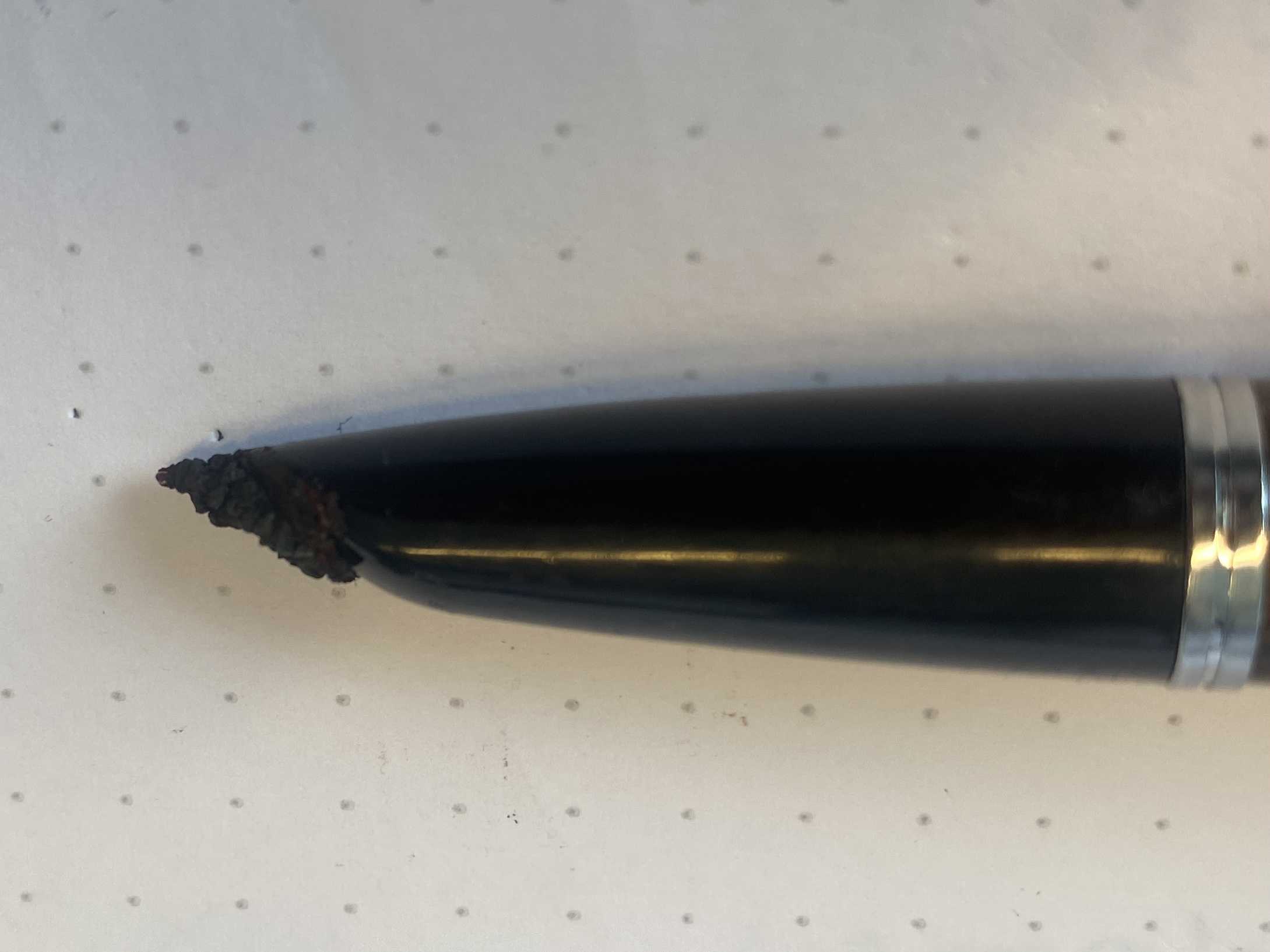Revitalize Your Fountain Pen in Minutes
In our fast-paced world, the art of maintaining a fountain pen may seem archaic. Yet, for connoisseurs, a well-functioning pen is essential.
This guide explores the science and art of cleaning your fountain pen. You’ll learn about the mechanics, identify when a cleaning is due, and delve into the intricate process of disassembling, cleaning, and reassembling.
Let’s breathe new life into your writing companion, ensuring its longevity and optimal performance.
Key Takeaways
- Regular cleaning is important for maintaining optimal performance of a fountain pen.
- Fountain pens should be cleaned every 4 to 8 weeks and when changing from one ink to another.
- Basic cleaning steps include disassembling the pen, rinsing the section, soaking it in clean water, drying it completely, and reassembling the pen.
- Flushing the pen is recommended for poorly writing pens or when changing inks, and involves disassembling, rinsing, flushing the filling system, soaking the nib section, and reassembling the pen.
Understanding Fountain Pen Mechanics
It is vital to understand a fountain pen’s intricate mechanics, as they directly influence the pen’s performance and determine the necessity for maintenance. The pen operates through capillary action, drawing ink from the reservoir to the nib. This process, though elegant, is easily disrupted by the accumulation of dust, paper fibers, or dried ink within the nib and feed.
Such disruption manifests as sluggish ink flow, scratchiness, or skipping. Regular cleaning, therefore, becomes an integral part of maintenance. Changing ink colors also necessitates cleaning to prevent color muddling or unwanted ink reactions.
With a profound understanding of these mechanics, one can truly appreciate the artistry behind each stroke and maintain their fountain pen’s optimal performance.
Identifying Dirty Pen Symptoms
To maintain the optimal performance of your fountain pen, it is crucial to identify and understand the symptoms of a dirty pen.
The first sign often manifests as slow ink flow, indicating that dust or dried ink may obstruct the feed.
A pen that scratches against the paper or sporadically skips while writing, despite the nib being in good condition, also signals a need for cleaning.
Persistent ink blotting or inconsistent color saturation are further symptoms of a dirty pen.
Despite being filled with ink, a pen that does not write may have a blocked feed, an issue often resolved through thorough cleaning.
Recognizing these symptoms promptly allows for swift action, ensuring continuous, seamless innovation in your writing journey.
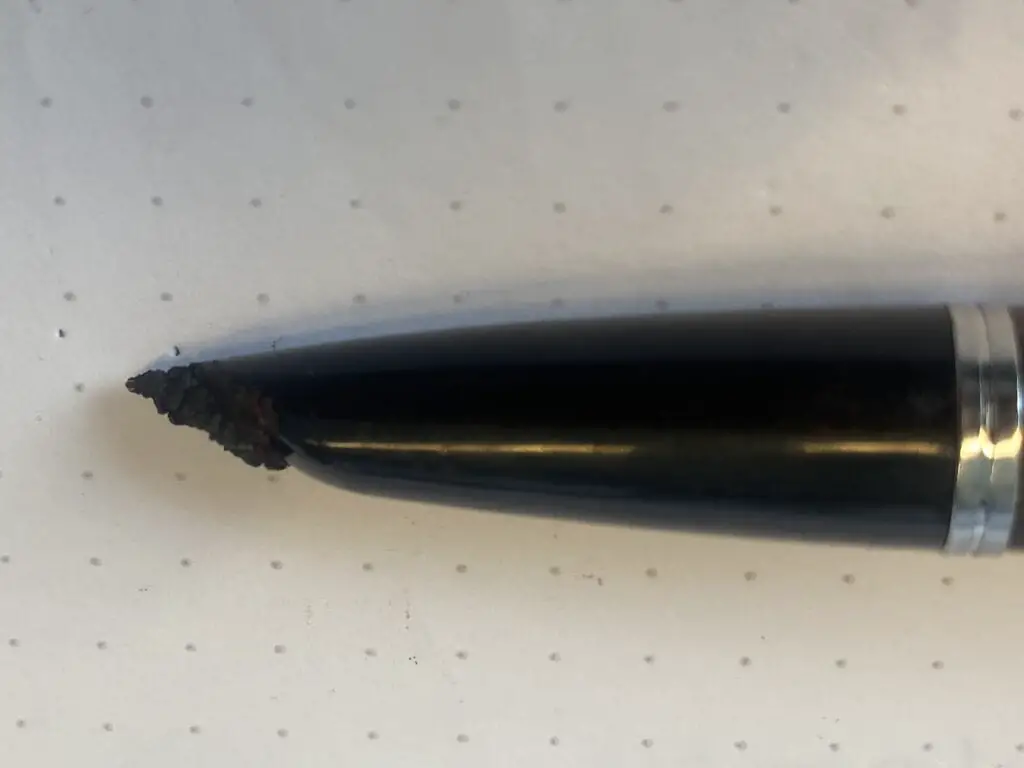
Ideal Fountain Pen Cleaning Frequency
Given the symptoms of a dirty pen discussed earlier, it becomes crucial to establish an optimal cleaning schedule for your fountain pen to ensure its longevity and performance. The ideal frequency of cleaning largely depends on usage and the type of ink used, but it generally ranges from every two weeks to once a month.
High-quality inks can prolong the cleaning cycle but cannot entirely prevent the need for regular maintenance.
If the pen is used infrequently, it should be cleaned before storing to prevent ink from drying in the nib.
Clean the pen thoroughly to avoid unwanted color mixing if you change ink colors frequently.
Always refer to manufacturer guidelines for specific cleaning instructions, which may vary based on the pen model. This detail-oriented approach assures optimal pen performance.
Basic Fountain Pen Cleaning Steps
Maintaining a clean fountain pen involves five steps that ensure optimal performance and longevity of your writing instrument.
First, disassemble the pen by uncapping and unscrewing the nib section. Rinse this part under cool, running water to dislodge ink or debris.
Subsequently, immerse the section in clean water, changing the water until it remains untinted, indicating all ink has been removed.
Ensure the section is dried entirely, placing it nib-down in a cup with a cloth or paper towel to absorb any residual moisture.
Finally, reassemble the pen by installing the cartridge or converter and screwing the nib section back on.
This fastidious routine will refresh your fountain pen, ensuring it produces smooth, vibrant lines every time.
Importance of Disassembling Your Pen
Proper disassembly of your fountain pen plays a crucial role in the thorough cleaning process, allowing each component to be individually inspected and cleaned, thereby preventing any ink buildup or blockages that could hamper its performance. Not only does this meticulous process ensure optimal functionality, but it also extends the lifespan of your writing instrument by preventing wear and tear.
- Nib and Feed: These parts are most prone to ink accumulation. Careful disassembly allows for focused cleaning.
- Ink Reservoir: Over time, residues can form. Disassembling helps in thorough cleaning.
- Cap: It can harbor dried ink or dust. Disassembling facilitates comprehensive cleaning.
- Clip and Finial: Disassembling these offers the opportunity to polish the pen to its original luster.
In essence, disassembly is a fundamental step to revitalize your fountain pen.
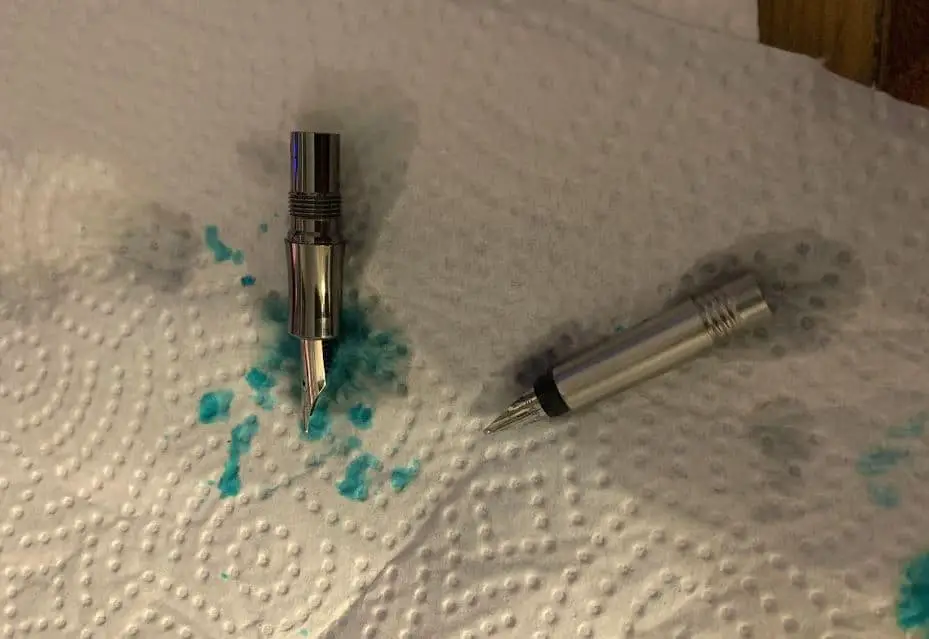
Correct Rinse and Soak Procedures
The rinse and soak process of fountain pen maintenance is a pivotal procedure that thoroughly removes all residual ink, dust, and debris from the pen’s components.
This purification process begins by disassembling the pen and rinsing each piece under cool, running water. It is essential to avoid hot water as it can damage the pen’s delicate materials.
After rinsing, the components are soaked in fresh water, allowing time for the ink to dissolve. The soaking water should be regularly replaced until it remains clear, indicating all ink has been eliminated.
Finally, a meticulous drying process is performed, preferably placing the nib section downward in a cup lined with a cloth or paper towel.
This comprehensive rinse and soak procedure is a cornerstone of fountain pen revitalization, rejuvenating your writing instrument for optimized performance.
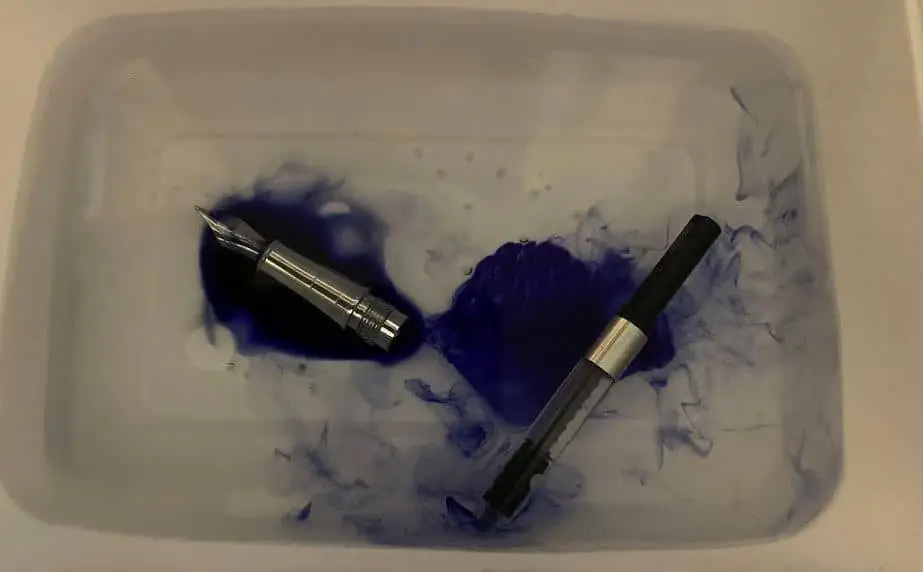
Drying and Reassembling Your Pen
After the thorough rinse and soak procedure, focusing on the drying and reassembly phase is crucial to ensure your fountain pen’s longevity and optimal performance.
To ensure a successful drying process:
- Always allow the pen parts to dry completely before reassembling to prevent ink dilution or potential damage from moisture.
- Pat dry gently with a soft, lint-free cloth, taking extra care not to damage the nib.
- For thorough drying, consider leaving the parts to air dry overnight.
Reassembling should be done with precision:
- Ensure all parts are in their rightful place.
- The nib and feed should align perfectly.
- Screw all parts together firmly, but avoid overtightening, which can lead to damage.
The Flushing Process Explained
Ink flow disruptions, a common issue in fountain pens, can often be remedied through a thorough flushing process.
This process involves disassembling the pen and flushing the filling system by filling and emptying the ink chamber with water. Cycle water in and out of the feed using the converter or filling system. This will effectively flush out any residual ink, dust, or paper fibers that may have lodged in the nib and feed, disrupting the pen’s capillary action.
The nib section is then soaked to dissolve any remaining ink traces. Upon completion of the procedure, your pen should be primed for a seamless, invigorated writing performance.
Flushing is vital to maintaining the artistic and innovative experience of using a fountain pen.
Introduction to Fountain Pen Cleaning Accessories
Transitioning from the flushing process and utilizing appropriate fountain pen cleaning accessories can significantly enhance the efficacy and ease of the entire pen maintenance routine. Introducing these tools into your cleaning regimen allows you to maintain your writing instrument’s optimal performance and longevity, ensuring a seamless writing experience.
The following cleaning accessories are handy:
- Ink Syringes: These allow precise control when flushing ink out of a fountain pen.
- Bulb Syringes: These are handy for flushing water through the pen body.
- Silicone Grease: This helps to waterproof the pen and prevent ink leakage.
- Brass Shims: These thin sheets are used to clean between the nib’s tines.
Each tool has a unique function that contributes to thoroughly and effectively cleaning your fountain pen.
DIY Fountain Pen Cleaning Solutions
Equipped with the right tools, you can create effective DIY cleaning solutions for your fountain pen, enhancing its functionality and lifespan.
A simple yet powerful mixture can be made from distilled water and a few drops of clear dish soap. This concoction can dislodge stubborn ink residue when used judiciously, ensuring smooth ink flow.
A diluted solution of one part household ammonia to ten parts water can be utilized for hardened ink deposits. However, frequent use of this potent mix should be avoided as it could harm the pen’s material.
An innovative approach is to use an ultrasonic cleaner, which could efficiently and safely clean your precious writing tool.
Always rinse thoroughly after using any cleaning solution to prevent unwanted reactions with the ink.
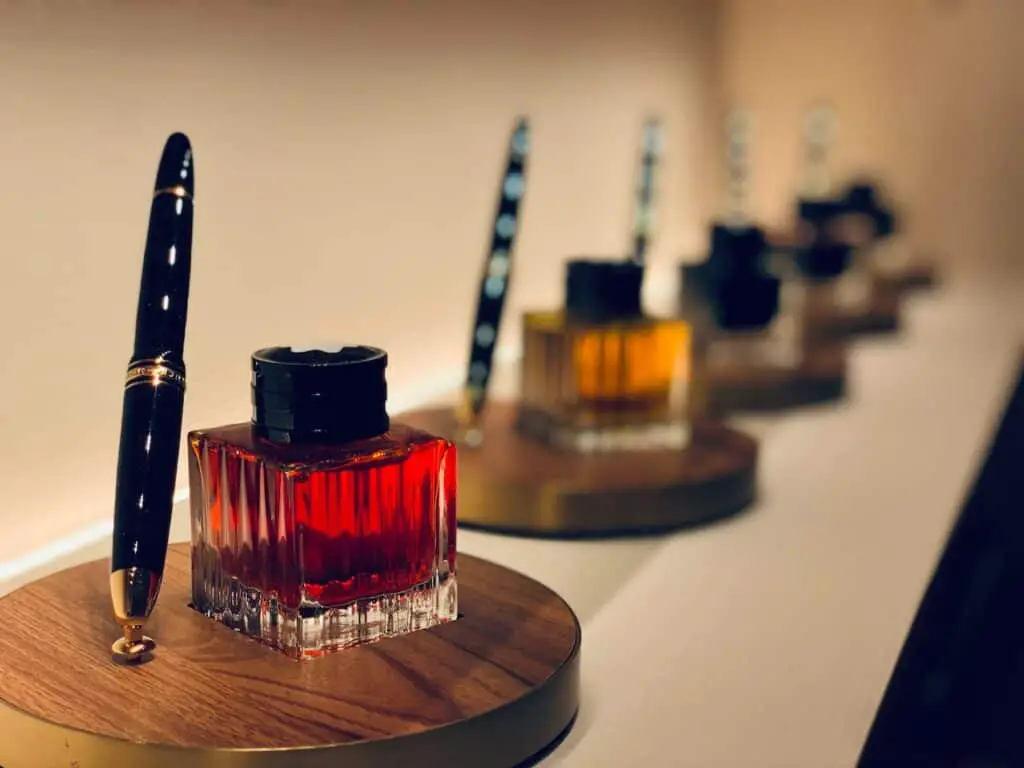
Conclusion
In conclusion, meticulous fountain pen maintenance involves a few key steps. Regular cleaning, flushing, disassembly, and correct reassembly are critical for preserving its intricate mechanics. Additionally, using appropriate cleaning accessories and solutions can significantly enhance this process.
This art of reinvigorating a fountain pen is crucial for sustaining its optimal performance and prolonging its lifespan. Therefore, it becomes an essential ritual for every fountain pen connoisseur.

